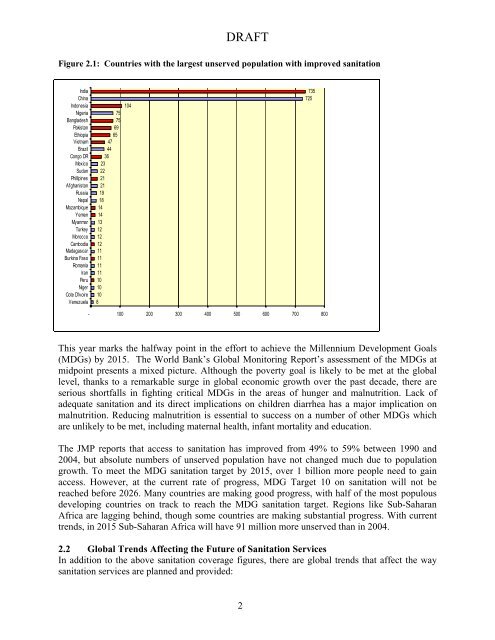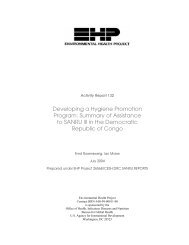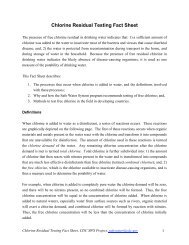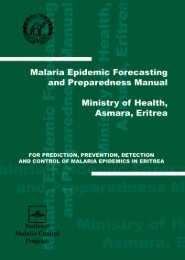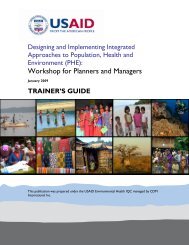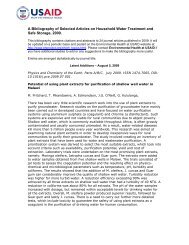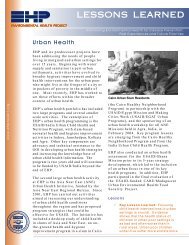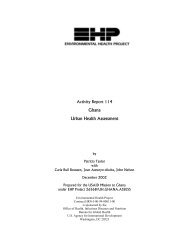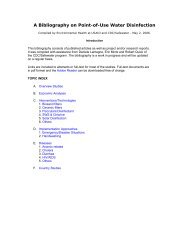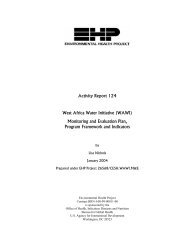The Water and Sanitation Program - Environmental Health at USAID
The Water and Sanitation Program - Environmental Health at USAID
The Water and Sanitation Program - Environmental Health at USAID
Create successful ePaper yourself
Turn your PDF publications into a flip-book with our unique Google optimized e-Paper software.
DRAFTFigure 2.1: Countries with the largest unserved popul<strong>at</strong>ion with improved sanit<strong>at</strong>ionIndiaChinaIndonesiaNigeriaBangladeshPakistanEthiopiaVietnamBrazilCongo DRMexicoSudanPhillipinesAfghanistanRussiaNepalMozambiqueYemenMyanmarTurkeyMoroccoCambodiaMadagascarBurkina FasoRomaniaIranPeruNigerCote D'IvoireVenezuela75756965474436232221211918141413121212111111111010108104735725- 100 200 300 400 500 600 700 800This year marks the halfway point in the effort to achieve the Millennium Development Goals(MDGs) by 2015. <strong>The</strong> World Bank’s Global Monitoring Report’s assessment of the MDGs <strong>at</strong>midpoint presents a mixed picture. Although the poverty goal is likely to be met <strong>at</strong> the globallevel, thanks to a remarkable surge in global economic growth over the past decade, there areserious shortfalls in fighting critical MDGs in the areas of hunger <strong>and</strong> malnutrition. Lack ofadequ<strong>at</strong>e sanit<strong>at</strong>ion <strong>and</strong> its direct implic<strong>at</strong>ions on children diarrhea has a major implic<strong>at</strong>ion onmalnutrition. Reducing malnutrition is essential to success on a number of other MDGs whichare unlikely to be met, including m<strong>at</strong>ernal health, infant mortality <strong>and</strong> educ<strong>at</strong>ion.<strong>The</strong> JMP reports th<strong>at</strong> access to sanit<strong>at</strong>ion has improved from 49% to 59% between 1990 <strong>and</strong>2004, but absolute numbers of unserved popul<strong>at</strong>ion have not changed much due to popul<strong>at</strong>iongrowth. To meet the MDG sanit<strong>at</strong>ion target by 2015, over 1 billion more people need to gainaccess. However, <strong>at</strong> the current r<strong>at</strong>e of progress, MDG Target 10 on sanit<strong>at</strong>ion will not bereached before 2026. Many countries are making good progress, with half of the most populousdeveloping countries on track to reach the MDG sanit<strong>at</strong>ion target. Regions like Sub-SaharanAfrica are lagging behind, though some countries are making substantial progress. With currenttrends, in 2015 Sub-Saharan Africa will have 91 million more unserved than in 2004.2.2 Global Trends Affecting the Future of <strong>Sanit<strong>at</strong>ion</strong> ServicesIn addition to the above sanit<strong>at</strong>ion coverage figures, there are global trends th<strong>at</strong> affect the waysanit<strong>at</strong>ion services are planned <strong>and</strong> provided:2


